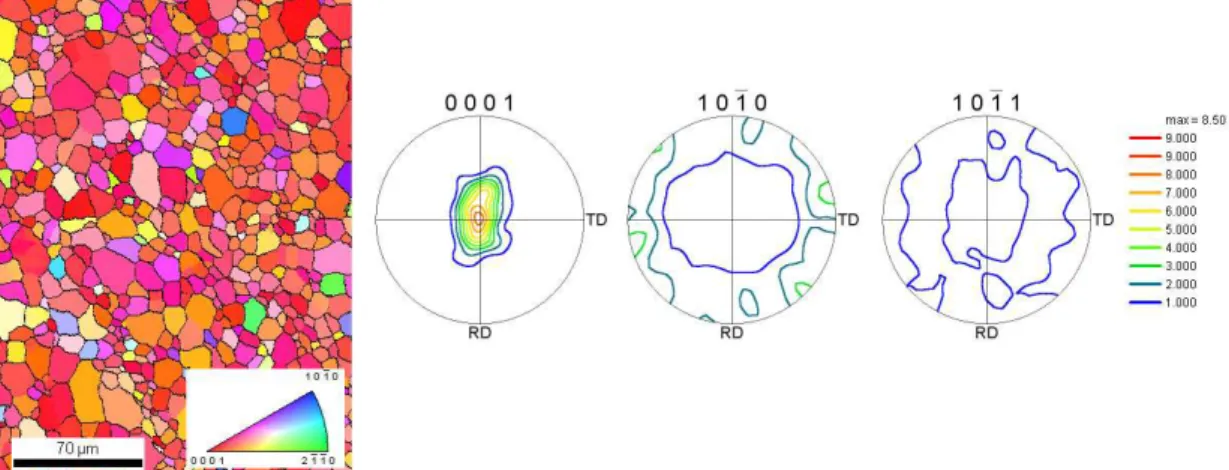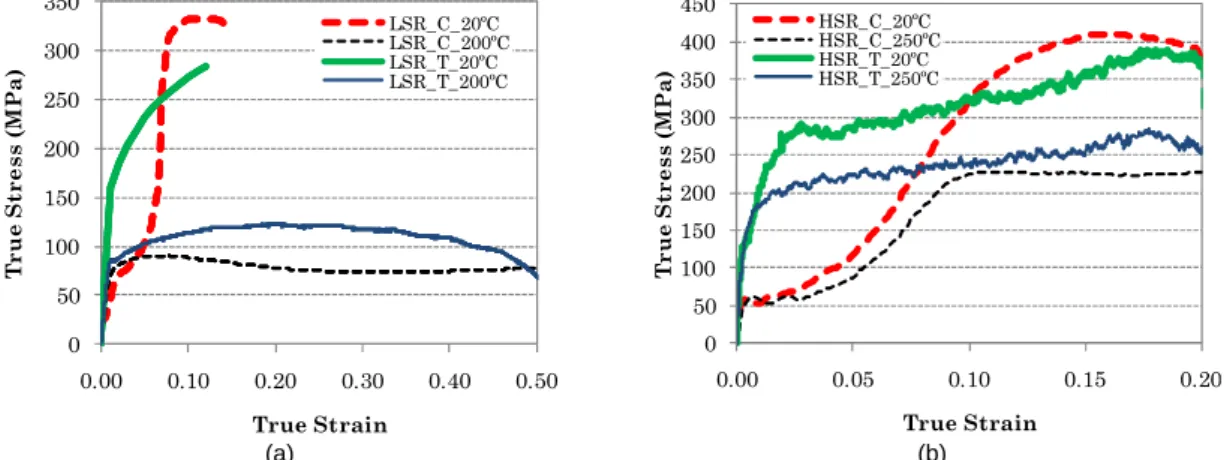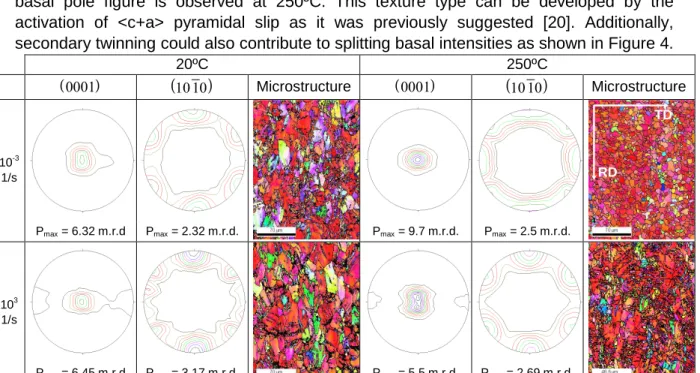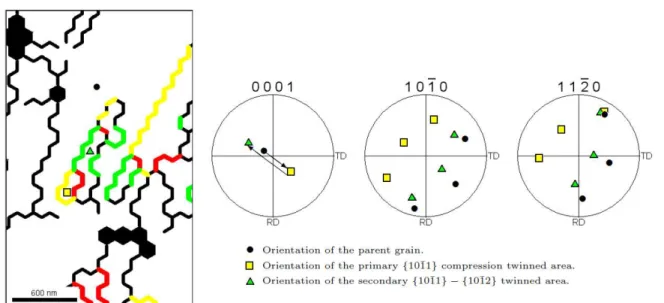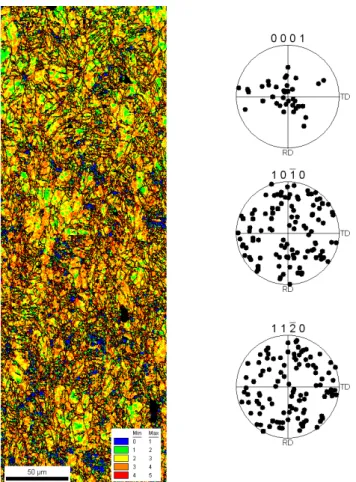I. Ulacia 1 , S. Yi 2 , M.T. Pérez-Prado 3 , N.V. Dudamell 3 , F. Gálvez 4 , D. Letzig 2 and I. Hurtado 1
1
Mondragon Goi Eskola Politeknikoa, Mondragon Unibertsitatea, 20500 Mondragon, Spain
2
GKSS Research Center, 21502 Geesthacht, Germany
3
Madrid Institute for Advanced Studies in Materials, IMDEA Materials, 28040 Madrid, Spain
4
ETS Ingenieros de Caminos, Universidad Politécnica de Madrid, 28040 Madrid, Spain
Abstract
In the current contribution the mechanical behaviour at high strain rates of AZ31 magnesium alloy sheet is studied. Uniaxial deformation properties were studied by means of tensile split Hopkinson pressure bar (SHPB) at different temperatures. The influence of the strain rate and temperature on the deformation mechanisms was investigated by means of electron backscatter diffraction (EBSD) and neutron diffraction. It is shown that twinning plays an important role on high strain rate deformation of this alloy, even at elevated temperatures. Significant evidence of prismatic slip as a deformation mechanism is observed, also at warm temperatures, leading to the alignment of <10-10> directions with the tensile axis and to a spread of the intensities of the basal pole figure towards the in-plane direction perpendicular to the tensile axis. The rate of decrease of the CRSS of non-basal systems is observed to be slower than at quasi-static rates. Secondary twinning and pyramidal <c+a> slip were also outlined for some conditions. At warm temperatures, in contrast to quasi-static range, a generalized dynamic recrystallization is not observed.
Moreover, the activation of rotational recrystallization mechanisms is reported.
Keywords
High strain rate, Magnesium Alloy, Texture
*
This work is based on the results of MAGNO2008 and MANUFACTURING 0,0 projects;
the authors would like to thank Spanish Ministry and Basque Government for its financial
support.
1 Introduction
Magnesium alloys have been thoroughly studied in the last decades due to their low density and thus their potential to reduce weight of any structure. Even though large number of studies have been carried out on the plastic deformation behaviour of magnesium alloys, most of them have their focus on the materials response under quasi- static loading conditions (e.g. [1-10]). However, in some structural applications, components must be designed to operate over a broad range of strain rates and temperatures. For instance, the high strain rate behaviour is of great interest to automotive, aerospace and/or defence industries because some critical components should have the proper mechanical properties to work under severe loading conditions, such as crash or impact. Furthermore, in most metalworking processes, materials undergo large amounts of strain at different strain rate and temperature conditions. High strain rate deformations (in the order of 10
3s
−1) are subjected to the materials in some innovative manufacturing methods such as in electromagnetic forming operations, owing to an increase in the forming limit as reported in [11] for Mg AZ31 alloy.
The mechanical behaviour and deformation mechanisms of magnesium and its alloys at low strain rates have been extensively investigated. Slip in hexagonal close packed (hcp) metals may take place along the <11-20> (<a>) direction, mainly on {0001}
basal plane, but also on non-basal planes, such as {10-10} prismatic and {10-11}
pyramidal planes. Additionally, second order pyramidal <c+a> slip has also been observed along {11-22} planes [2]. Deformation is also accommodated by twinning, mainly along {10-12} and {10-11} planes, so called extension and compression twinning respectively. Apart from single twinning, secondary twinning from a primary twin ({10-11} – {10-12}) was also reported in magnesium single crystals by Wonsiewicz and Backofen [4].
Recently, Barnett et al. [3] have also shown non-Schmid behaviour of this secondary twinning by EBSD and TEM investigations.
It is generally accepted (e.g. [2, 5, 6]) that at room temperature, slip on basal planes and {10-12} twinning are the main deformation mechanisms in uniaxial deformations at low strain rates. However, deformation temperature plays an important role in the activity of different deformation modes. The critical resolved shear stress (CRSS) for basal slip and {10-12} twinning is temperature independent [5]. Meanwhile, the CRSS for prismatic and pyramidal systems decrease with increasing temperature, even to smaller values than {10-12} twinning. Moreover, at temperatures higher than 200ºC dynamic recrystallization takes places simultaneously [7-9]. The activation of these additional mechanisms results in an increase of ductility and a decrease of yield and flow stress.
The low availability of independent slip systems makes Mg alloys highly dependent on texture [10]. It is further emphasized by the polarity of {10-12} twinning, which only allows shear in one direction (opposed to forward and backward shear in deformation by slip) [12]. When investigating rolled or extruded magnesium, as they develop strong texture during processing, the dependence of the initial texture on the deformation mechanisms and thus the mechanical properties is more pronounced. For example, a strong tension-compression asymmetry at low strain rates has been reported and related to texture.
The deformation behaviour of Mg alloys at high strain rates (10
3s
-1) has not been
thoroughly investigated yet [13-17]. Generally, it has been concluded that ductility
increases with increasing the strain rate [13-15]. Additionally, twinning has been observed
to significantly contribute to plastic deformation even at high temperatures, at which it is
mostly suppressed at quasi-static strain rates. However, most of the studies carried out to date mostly dealt with extruded or casted Mg alloys and predominantly under compressive loading. Above all, the influence of temperature, loading condition (tension-compression) and texture on the deformation mechanisms and flow stress at high strain rates is still unknown.
In the current study, the uniaxial mechanical behaviour of AZ31 sheet under dynamic conditions (10
3s
-1) was analyzed and compared with that observed at low strain rates. AZ31 sheets have been tested in tension and compression using Hopkinson bar apparatus from 25ºC to 400ºC. Detailed microstructure and texture examination by electron backscatter diffraction (EBSD) and neutron diffraction has been carried out to elucidate the predominant deformation and recrystallization mechanisms.
2 Experimental procedure
2.1 Initial material. Microstructure and crystallographic texture analysis
The initial material used in this study was the commercial-grade Mg alloy AZ31. Two rolled and annealed sheets, 1 and 3 mm thickness, were used.
The microstructure and texture of the as-received material was analyzed by electron backscatter diffraction (EBSD) employing EDAX-OIM
TMsoftware in a Zeiss Ultra 55
TMFEG-SEM scanning electron microscope. Sample preparation for EBSD included grinding up to 4000 SiC paper, mechanical polishing with a 0.05 µm silica suspension and final electro-chemical polishing for 90 s at 33 V using the AC2
TMcommercial electrolyte. The microstructure is presented by EBSD orientation maps and the texture by recalculated pole figures. Since EBSD only allows examination of the local texture, macrotexture measurements were also performed by means of neutron diffraction in the Stress-Spec instrument from FRM-II of the TU-Munich (Germany) with a beam size of 5 mm diameter.
The initial microstructures of the two AZ31 sheets of 1 and 3 mm thickness were formed of equiaxed recrystallized grains with average intercept sizes of 10 and 13 µm respectively (Figure 1). As generally observed in annealed AZ31 sheets, both sheets show strong basal type texture (i.e. crystallographic c-axes are aligned in the sheet normal direction). It can also be seen in the pole figure from Figure 1 that the <0001> fiber is not perfect and a spread of the basal poles toward sheet rolling direction (RD) is present.
Neutron diffraction measurements were consistent with the EBSD measurements.
Figure 1: Microstructure and texture of the as-received AZ31 Mg alloy measured by
EBSD (The colour code corresponds to the normal direction -ND- inverse pole figure).
2.2 Mechanical testing
An exhaustive testing campaign was performed in order to compare high strain rate with quasi-static behaviour at different temperatures. Tensile tests were performed on the 1 mm thick sheet. The reader is referred to [18] for more detailed description of the testing procedures. High strain rate tests at 10
3s
-1were carried out using a tensile split Hopkinson bar. A radiative furnace was used for testing at several temperatures.
Thermocouples were glued to both surfaces of the specimens to measure the initial temperature of the sample. Quasi-static tensile tests were carried out using a conventional INSTRON-4206 testing machine equipped with a heating furnace. The specimens tested at low strain rates were machined according to ASTM E8 M-0 standard. At both high and low strain rates, tests were performed along RD at temperatures ranging from 25ºC to 300ºC (In-plane RD-TD anisotropy in tension can be seen in [19]). Compression testing was performed on the 3 mm thick sheet. High strain rate compression tests at 10
3s
-1were carried out using a Hopkinson bar apparatus. At both high and low strain rates, tests were performed along RD and ND at temperatures ranging from 25ºC to 400ºC. The specimens compressed along RD were 3 x 3 x 4.5 mm while the samples compressed along ND were 3 x 3 x 3 mm cubes (See [19] for the ND-RD anisotropy in compression).
The microstructure and texture of the samples deformed in tension were examined by EBSD and also by neutron diffraction (procedure explained above). Microstructural analysis of the samples deformed in compression could not be performed because the specimens were smashed during testing.
3 Results and discussion
3.1 Mechanical behaviour at high strain rates
Figure 2 shows true stress - true strain curves comparing tension-compression behaviour at different strain rate and temperature conditions. It is observed that at room temperature the shape of the curves is concave down under tensile loading and concave up under compressive loading. The tension-compression asymmetry, generally observed at low strain rates and room temperatures, is maintained at high strain rates. These stress differences are consistent with the predominance of crystallographic slip in tension and {10-12} twinning followed by strain hardening in compression.
0 50 100 150 200 250 300 350
0.00 0.10 0.20 0.30 0.40 0.50
True Stress (MPa)
True Strain
LSR_C_20ºC LSR_C_200ºC LSR_T_20ºC LSR_T_200ºC
0 50 100 150 200 250 300 350 400 450
0.00 0.05 0.10 0.15 0.20
True Stress (MPa)
True Strain HSR_C_20ºC
HSR_C_250ºC HSR_T_20ºC HSR_T_250ºC
